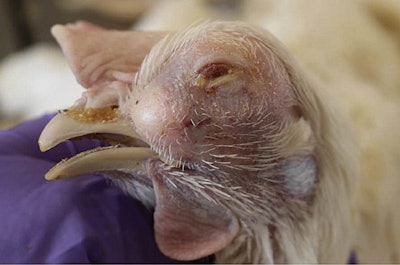
Autogenous vaccines and bacterins are custom products approved by the U.S. Department of Agriculture (USDA) for use in specific situations under direction of a veterinarian. The intent of the law is to allow these products to be used when commercially licensed products are not available or have not provided adequate disease protection.
A virus or bacteria is isolated from a specific farm or operation and sent to a laboratory for identification, at least to the family level for viruses and genus and species level for bacteria. If planned to be used for more than a year in an autogenous product, an isolate should also be characterized with the strain and/or serotype. The isolate is sent to a licensed manufacturer to be grown to adequate levels, inactivated and mixed with an adjuvant.
Autogenous products are tested for safety and purity for the initial serial and an additional identification test is done on subsequent serials. If isolates are used more than two years, immunogenicity testing is also required.
Issues associated with the need for vaccine
In the United States, an infectious coryza (Avibacterium paragallinarum) outbreak in commercial layers has led to shortages of commercial bacterins and a sharp increase in demand of autogenous products. The normally tropical disease has been present for many years in California, southern Texas and Florida, but has more recently emerged in Kentucky, Virginia, Arizona and Pennsylvania.
Commercial products have a very long lead time in the production and approval process due to extended live bird testing in older pullets of each strain contained in the product. Vaccination does not prevent infection, and even well-protected birds continue to shed the bacteria, making it very difficult to eradicate without depopulation of the farm.
Bob Evans, technical consultant at Elanco, says: “All autogenous products require two doses to provide full protection. The first dose stimulates IgM antibodies and the second dose stimulates IgG immunity.” He said the current coryza bacterin shortage has left some producers with only enough product to vaccinate one time, resulting in to less-than-desired protection. Clinical signs, mortality and significant production drops are likely the result of incomplete immunity.
Several respiratory pathogens not adequately protected by standard commercial products have been requested by producers for formulation of autogenous products. These include infectious bronchitis variants which cause false layer syndrome, mycoplasma, emerging E. coli serotypes and Ornithobacterium rhinotracheale (ORT).
Veterinarians assisting producers may recommend autogenous products with multiple pathogens. Kelli Jones, technical services manager at Ceva, says: “In complicated situations, we are often able to isolate various disease organisms. So we recommend a multivalent autogenous product as we can’t determine how much each individual organism is contributing to production losses. It’s not uncommon for these diseases to be less dramatic on their own, but when presented as a secondary pathogen, the clinical picture changes quickly.”
Jones reports that customers have requested autogenous products with E. coli, Gallibacterium anatis, ORT, and infectious coryza as all were isolated on the same farm.
The aforementioned Gallibacterium anatis is mentioned more frequently as being responsible for moderate production losses and increased mortality. Autogenous bacterins are helping reduce lesions in ovaries, liver and oviducts, which can also result in egg shell quality issues.

Primary shell gland infection with G. anatis results in wrinkled eggshells. (Kelli Jones)
Less common Salmonella serotypes are also requested by producers in autogenous products as one tool to help reduce and control infection on a facility. These products are used with other interventions as vaccination alone will not achieve the desired impact.
Duck atadenovirus A, which produces a disease called egg drop syndrome ’76, has been confirmed in Pennsylvania and has producers requesting autogenous vaccines. This virus is endemic in other parts of the world and can be transmitted by waterfowl. Vaccination will help prevent egg production drops of 10% to 40%, but birds become infected and continue to shed virus at lower levels than unvaccinated birds.

Egg drop syndrome ’76, transmitted by waterfowl, has been confirmed in Pennsylvania and has producers requesting autogenous vaccines. Egg shell problems are common with this disease. (Sherrill Davison)
Reappearing diseases
As pastured flocks increase, older soil-borne diseases are reappearing, which may require autogenous products. Erysipelas is a bacterial disease which can cause costly mortality. Most commercial products are labeled for swine and turkey use.
Fowl cholera is another bacterial disease capable of causing losses due to mortality and production drops. There are live and inactivated commercial products which provide varying levels of protection against serotypes not included in the products.
Spotty liver disease is another re-emerging condition caused by Campylobacter hepaticus and is most commonly seen in pastured flocks. This organism is easy to isolate, but challenging to grow in laboratory conditions. However, autogenous products are in development and anticipated soon. Mortality can reach 5% and egg production drops are commonly noted between 5% and 20%.
Biologics companies licensed to produce autogenous products include Boehringer Ingelheim, Ceva, Elanco, Epitopix and Hygieia Biological Laboratories. Each company has unique approaches to the layer autogenous market.
While not required, some companies work up a submission and research an organism and may include pathogenicity, immunogenicity or cross-protection studies. The manufacturer may also apply proprietary technologies to ensure the autogenous product has the best opportunity to prevent disease. Companies also differentiate themselves with formulation standards and adjuvant technologies.
Due to the long productive life of a layer, conclusive research with controlled side-by-side studies to evaluate customized health products is prohibitive in most cases. Producers rely on trusted relationships with suppliers, good diagnostics, veterinary advice and field experience to find a proper solution to health challenges.
As disease organisms are constantly changing, it’s very important for producers to be informed and have a full arsenal of tools at their disposal to use when the need arises.

















